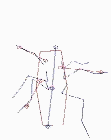|
|
|
|
|
|
|
|
|
|
| Conclusions
|
|
 |
Implementation of this approach has yielded surprising results. Although the simulated and kinematic data are largely dissimilar, this was expected given the extreme simplicity of the model used. Despite this simplicity, however, the simulations resulted in self-stabilizing dynamic motion, even when large disturbances are added.
The sensitivity of the solution to the initial guess shows a weakness to the approach. However, as seen by the simulation, even very dissimilar system parameters solutions result in stable motion that is qualitatively similar to the kinematic data. Another alternative would have been to use individual foot-force data measured for the cockroach and to solve for the system parameters that results in similar foot forces. It is interesting that it seems possible to infer dynamic properties strictly from motion data. This makes the approach applicable to situations in which force measurements are not possible. This study was limited to finding the mechanical properties of a simple model that is the same size and mass as the cockroach. For robot design, this approach allows the designer to simply scale the kinematic data, and apply the same algorithm for a hexapedal robot of a desired mass and size. Scaling force data is not as straight-forward. The formulation of the model as a hybrid system revealed that the static force field drives the system towards an equilibrium point before switching, or resetting, to maintain the motion. The use of this equilibrium point yields a convenient frame on which to define the system and on which to make interesting assertions about a linear approximation of the system. Finally, an approximate set of the maximum velocity disturbances to the cycle was found which maintains the center of mass within the tripod of support. Future work will compare the stiffness and damping properties found with other current approaches to measuring the same properties in the cockroach. The application of this for the design of a next-generation Sprawlita-sized robot is also planned in addition to applying the same technique to the sagittal plane of the kinematic data. |
| REFERENCES | |
| Full, R.J., Autumn, K., Chung, J.I., Ahn, A., "Rapid negotiation of rough terrain by the death-head cockroach." American Zoologist. 38:81A. 1998. Pandy, M. G., Zajac, F. E., Sim, E., Levine, W. S., "An Optimal control model of maximum-height human jumping" J. Biomechanics, 23:1185-1198, 1990. Popovic, Z. and Witkin, A., "Physically based motion transformation." In Computer Graphics (SIGGRAPH 91 Proceedings), vol. 25, p349-358, July 1991. Raibert, M. H., "Legged robots that balance." MIT Press, Cambridge, MA. 1986. U. Saranli, M. Buehler, and D. E. Koditschek, "An Autonomous Hexapod Runner," IEEE Trans. Robotics and Automation, Proceedings of ICRA 2000, San Francisco, CA. Witkin, A. and Kass, M., "Spacetime Constraints" In Computer Graphics (SIGGRAPH 88 Proceedings), vol 22, p159-168, Aug. 1988. |
|